Sarah Rosalena’s Standard Candle uncovers the forgotten history of female “computers”

Standing behind textiles from Standard Candle in my Los Angeles studio. Photos by Beryl Korot.
Sarah Rosalena (2021 Creative Capital Grantee) is rethinking astronomical observatory instrumentation through feminist and anti-colonial perspectives. Rosalena has been using digital weaving and Indigenous beading to reinterpret telescopic images in textile form for her Creative Capital project, Standard Candle. The body of work premieres this week at Mount Wilson Observatory. Staged in the observatory’s 100-inch Hooker telescope, the exhibition uses instrumentation and darkness as a lens for examining women’s labor and colonialism, and their role in the advancement of western scientific thought and the imaging of space.
In her Creative Capital Artist Diary, Sarah Rosalena shares what she hopes viewers will take away from the exhibition, and offers a look into how she created these incredible works—including her looms and over 300 hours of beadwork.
Standard Candle is presented by LACMA, and will be on view at Mount Wilson Observatory in Los Angeles, CA from May 6–June 4, 2023; plan your visit here. There will be a Conversation, Telescope Viewing, and Reception on May 6 from 7:00–11:30PM.
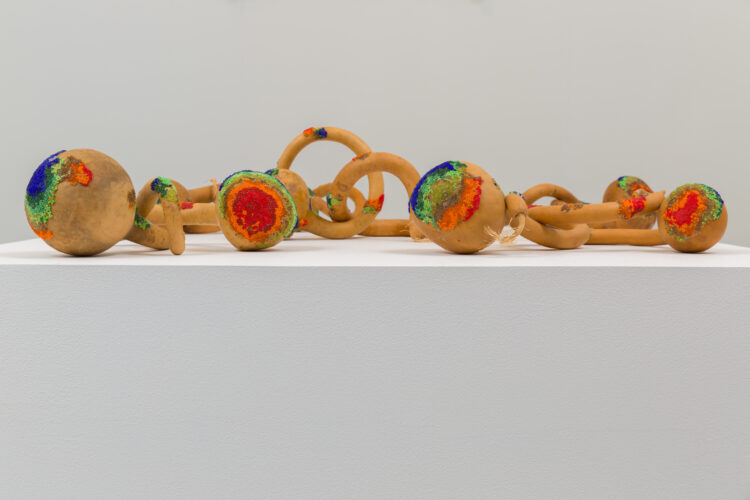
CMB, Glass beads, pine sap, tree resin, gourds, 13 gourds, various dimensions, 2022. Photo by Ian Byers-Gamber.
The idea of the exhibition was suggested by curator Joel Ferree in 2020 who runs the LACMA Art + Tech Lab for my research in female “computers” and their shared history in computing and textile production. I received the Art + Tech Lab Grant in 2019 for my scholarship in digital weaving. I am also a protester against the TMT telescope at Mauna Kea. At first, I was hesitant to do the exhibition. At the same time, I thought it might be critical because Mount Wilson Observatory’s placement in scientific origin and discovery where measurements of the universe were founded, including that our universe is expanding. I saw value in having an exhibition at the base of the observatory, which is mainly unfunctional due to light pollution, and its deconstruction and dismantling as a viewpoint of zero in astronomical measurement and site of origin.
My work deconstructs technology with material interventions, creating hybrid objects that function between human/nonhuman, ancient/future, handmade/autonomous, beyond power structures rooted in colonialism. They collapse binaries and borders, creating new epistemologies between Earth and Space. I am shaped by the origins, character, and assembly of weaving, including the Wixárika weaving tradition passed down my matrilineal bloodline. I carry this through to my position as the Assistant Professor of Computational Craft in the Department of Art at UC Santa Barbara.
 |
 |
A6990, A3393, D11362. Cotton, UV reactive yarn, 56.5 x 41 inches, 2023. Photo by Ian Byers-Gamber.
Eurocentrism is deeply entwined in aspects of science and technology through observation, including the rise of observatories in the American West during the early 20th century. Former researchers at Mount Wilson Observatory discarded most log books, names, processes, and research made by female “computers” over time. It is not uncommon for older observatories. My research was heavily reliant on information provided by Harvard Observatory to speculate and fill in critical gaps missing from their archive. In doing so, the negative space allowed room to reimagine what had been cropped and edited out from history through feminist and anti-colonial methodologies.
Prior to settler colonialism in Southern California, stars were visible under darkness, but their visibility is now threatened by light pollution from unceded Tongva land. The observatory provides a conceptual vantage point where men of science produced precise instruments for observation, claiming political and cultural power over knowledge and science. Mount Wilson Observatory is the origin point for measurement and galaxies beyond the Milky Way, shattering previous concepts of the universe.

Glass plates formerly used by female computers from the Mount Wilson Observatory archive at Carnegie Observatories in Pasadena, California. Image courtesy of the artist.
The exhibition materializes glass plate imagery used by female “computers” used to map the universe starting from the late 1800s at Mount Wilson Observatory, generating units of measurements for measuring the universe through a grid. Woven pieces are not one-to-one translations but rather reactive materials that generate new resolutions through glass, yarn, and paper thread—importantly, demonstrating how material resolution produces different knowledge with multi-cosmology rather than universal perspective. Works are activated through darkness, such as the lightboxes or woven with UV reactive yarn.
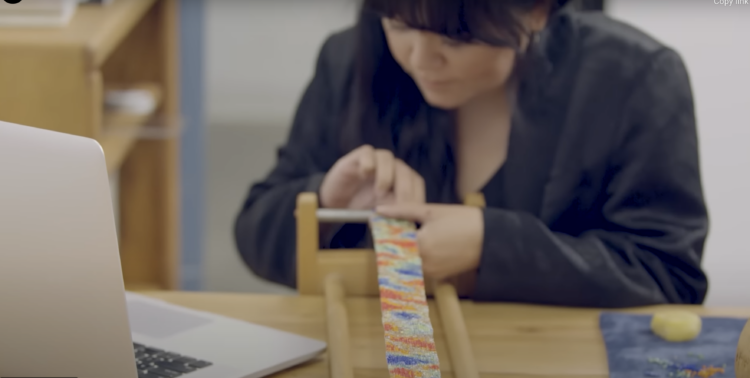

Sarah Rosalena weaving on her mother’s handloom.
Textiles were handwoven on a digital Jacquard loom, specializing in high-resolution imaging through complex weave structures. And the glass beaded textiles were made on my mother’s Wixárika handloom from techniques passed from her matrilineal bloodline and grandmother. Weave structures produce generative patterns that break away from the grid, while pulling focus to its inherited structure in imaging. By pointing to where universal mapping is constructed computationally, their authority and political entanglements of power are revealed, also their deconstruction.
 |
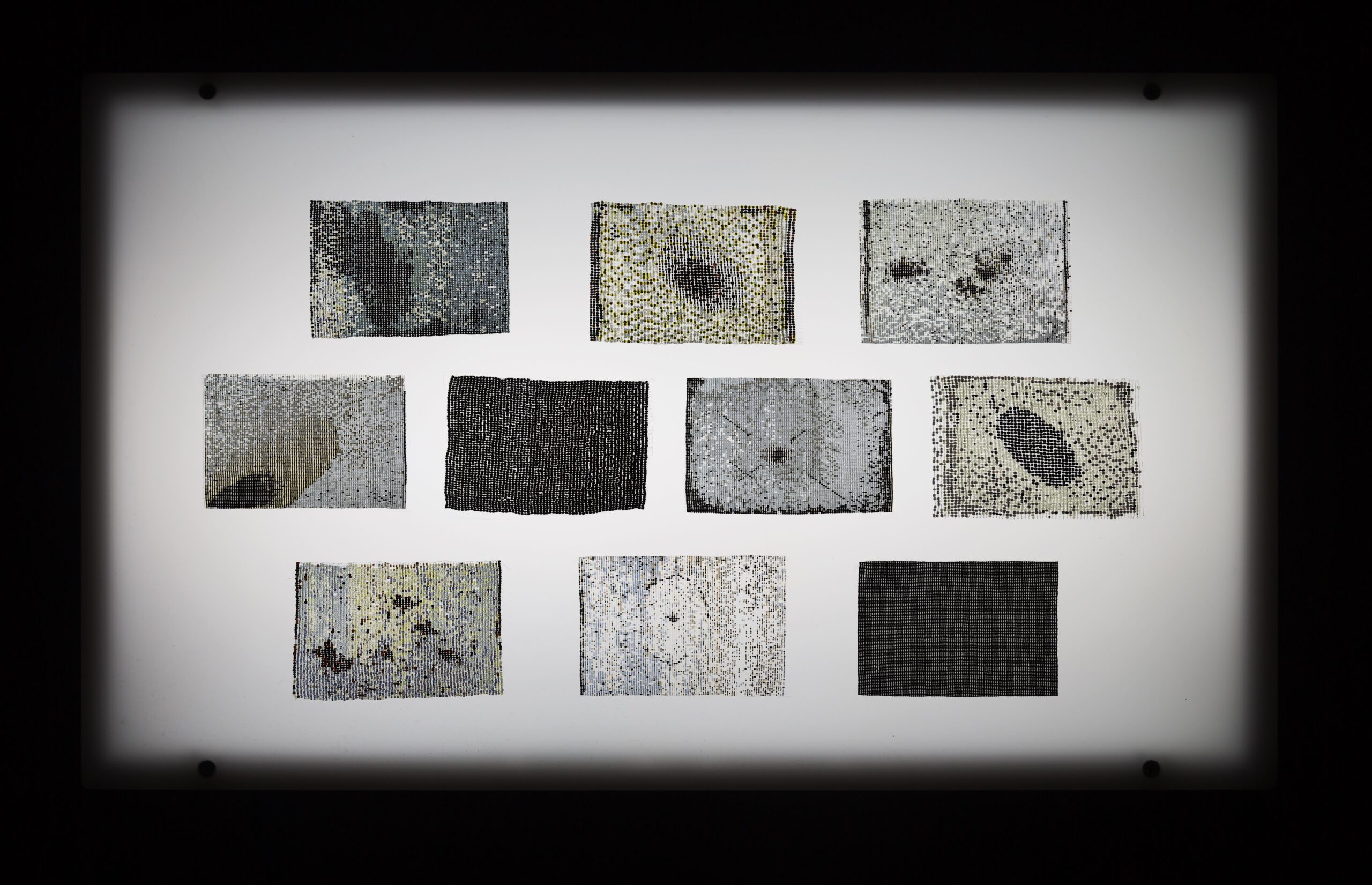 |
Expanding Axis, ten pieces, 4 x 6 inches, glass beads, thread, 2022. Photos by Ian Byers-Gamber.
This is my largest beadwork exhibition. I spent 300 hours beading over twenty works for the exhibition on my mother’s handloom and inlay on gourds. I often thought of my grandmother who has passed on, and had multiple dreams about her. Also, thinking about my body as an inherited algorithm. I believe she has been weaving with me in the process of the work. Each piece is made with a different size of glass bead. Pixel per bead is a powerful way to work through media, as it becomes the smallest physical point you can control an image in the material world. Also, demonstrating the power of resolution, and what is cropped, edited, or removed in translation.
 |
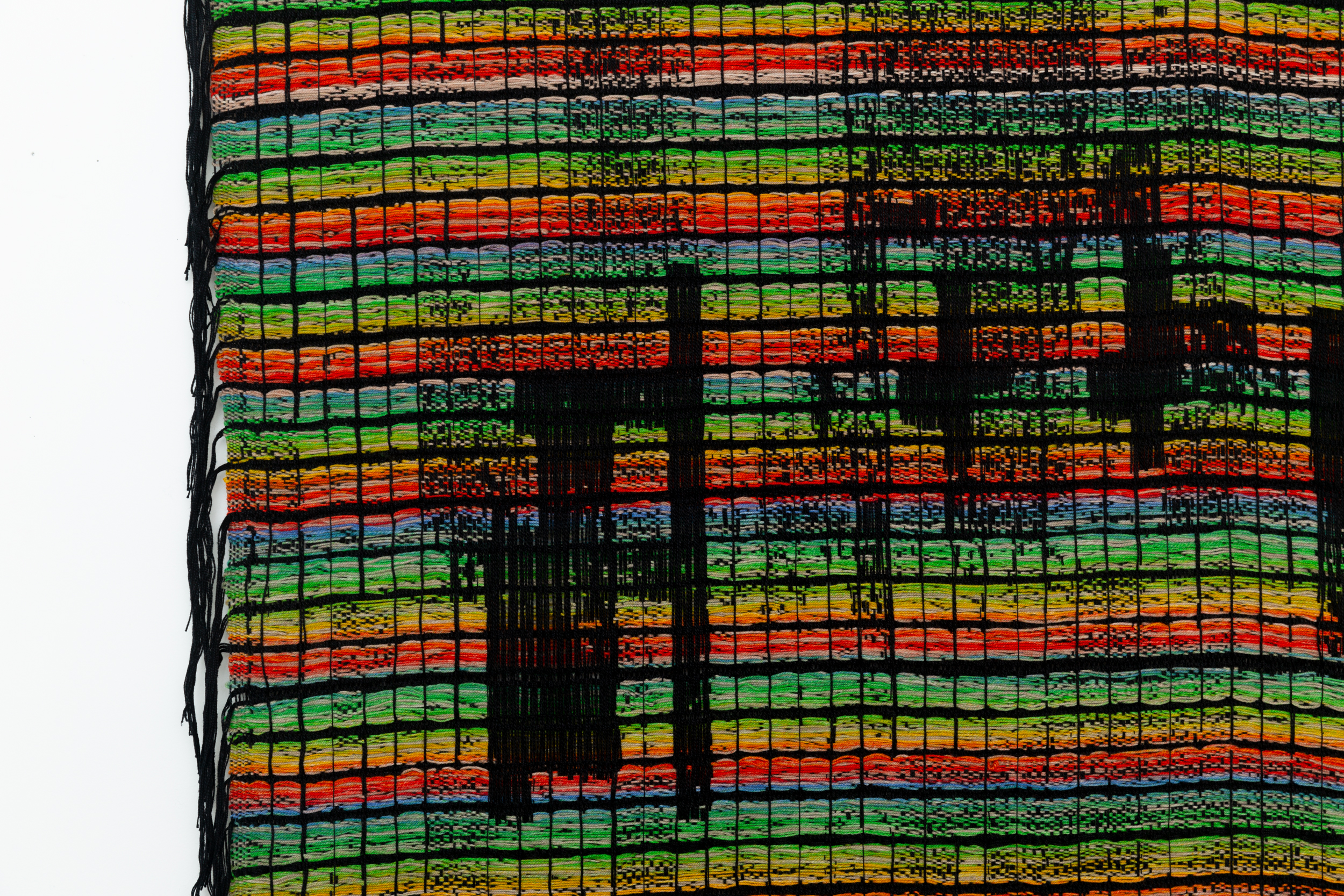 |
Exit Grid Spectra, Hand dyed wool yarn, 71 x 41 inches, 2023. Photo by Ian Byers-Gamber.
I hope that audiences take away the importance of multiple viewings of the universe outside Eurocentric science. The concept of land as a black box for scientific research continues on Indigenous land, which is why looking to the past is critical in the expansion of light pollution. In darkness, stars become visible, and so does the value of Indigenous knowledge, holding that darkness.
I’m also interested in bringing visibility to the hidden history and value of female labor in computation, pattern recognition, and imaging by hand. Female computers did complex data processing, image classification, categorization, and labor now transferred to machines and modern computing.

Exit VAR!, glass beads, thread, 23 x 4 inches, 2022. Photo by Ian Byers-Gamber.
I hope audiences view stars from a new perspective and appreciate their sacred knowledge in the darkness that renders them visible. Also, the value and importance of critical female labor used to produce images, including the value of Indigenous science and knowledge from where a majority of observatories stand.
Works in the show are like stars, activated in darkness, such as beadwork illuminated by light boxes and textiles woven with UV reactive yarn. Viewing stars provides a conceptual grounding that anchors us to land and time for cosmology and knowledge building.
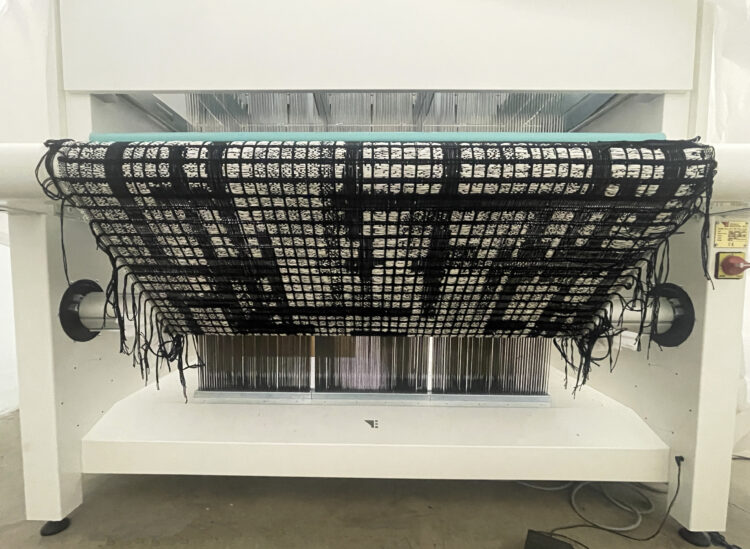
Loom view in my studio, weaving paper and cotton yarn. Photo courtesy of artist.
Creative Capital has been essential in my ability to purchase a TC2 Jacquard loom and be able to take time off from teaching as a professor to focus on critical weaving. I have been saving to buy a TC2 for over five years, and was previously weaving on a compu-dobby loom. It has dramatically improved my research in complex weave structures and research as Professor of Computational Craft at UCSB. I teach courses on digital weaving and the origins of Jacquard in computation.
I have used the loom for three solo textile exhibitions this year at the Columbus Museum of Art, the Museum of Contemporary Art Santa Barbara, and my Creative Capital project with LACMA at Mount Wilson Observatory.
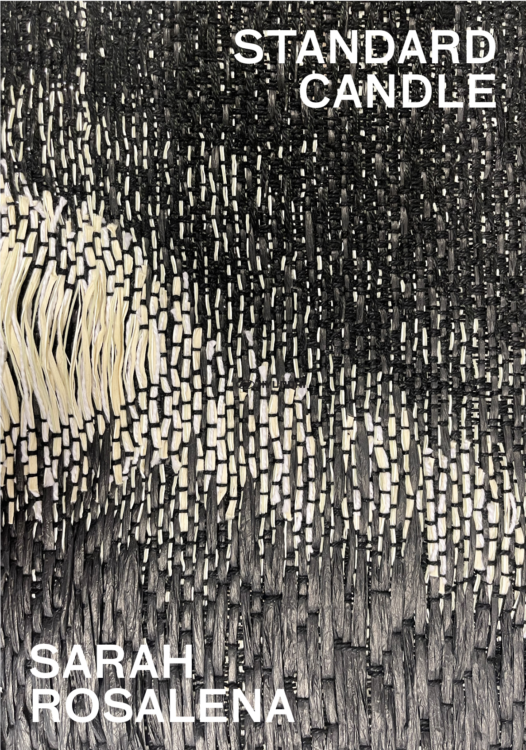
LACMA exhibition cover. Image credit: LACMA Art + Tech Lab, cover photo courtesy of artist.
LACMA is creating an exhibition poster for visitors as well as a special opening reception that is free to the public. The event includes an artist conversation with science and technology anthropologist Lisa Messeri on the context of origin and knowledge through feminist and anti-colonial methodologies, in addition to connections to computing shown throughout the exhibition of textiles and beadwork.
My advice for artists is to take on challenges, regardless of how much an institution opposes your research or critical dialogue. Be radical and strong with your voice. Take risks to produce new futures, as it can seem dangerous to decenter western traditions of art history, art institutions, science institutions, and contemporary art. Be brave and generate and protect community that is inclusive and diverse.
Standard Candle is presented by LACMA, and will be on view at Mount Wilson Observatory in Los Angeles, CA from May 6–June 4, 2023; plan your visit here. There will be a Conversation, Telescope Viewing, and Reception on May 6 from 7:00–11:30PM.
